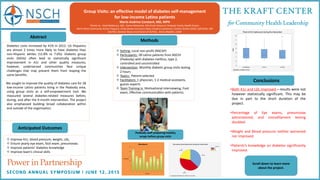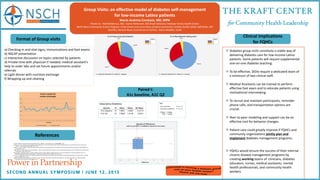This document describes a project that implemented group visits to improve diabetes care for 28 low-income Latino patients. The group visits occurred monthly for 2 hours and included checking vitals, immunizations, foot exams, interactive discussions on patient-selected topics, private time with physicians if needed, and a light healthy dinner. Key outcomes measured included A1c, blood pressure, weight, LDL, eye exams, and diabetes knowledge. While A1c and LDL did not show statistically significant improvements possibly due to the short duration, eye exams and diabetes knowledge did significantly increase. The group visit model showed potential to effectively deliver diabetes care and self-management support to underserved populations, but requires a dedicated clinical team and addressing social barriers like transportation.

